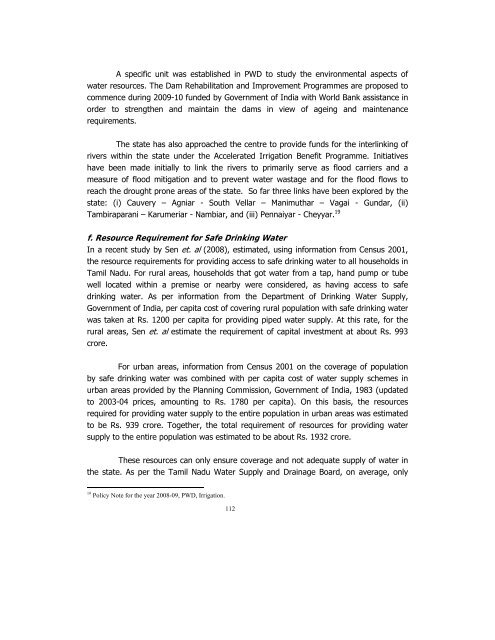POVERTY REDUCTION STRATEGY TN
Create successful ePaper yourself
Turn your PDF publications into a flip-book with our unique Google optimized e-Paper software.
A specific unit was established in PWD to study the environmental aspects of<br />
water resources. The Dam Rehabilitation and Improvement Programmes are proposed to<br />
commence during 2009-10 funded by Government of India with World Bank assistance in<br />
order to strengthen and maintain the dams in view of ageing and maintenance<br />
requirements.<br />
The state has also approached the centre to provide funds for the interlinking of<br />
rivers within the state under the Accelerated Irrigation Benefit Programme. Initiatives<br />
have been made initially to link the rivers to primarily serve as flood carriers and a<br />
measure of flood mitigation and to prevent water wastage and for the flood flows to<br />
reach the drought prone areas of the state. So far three links have been explored by the<br />
state: (i) Cauvery – Agniar - South Vellar – Manimuthar – Vagai - Gundar, (ii)<br />
Tambiraparani – Karumeriar - Nambiar, and (iii) Pennaiyar - Cheyyar. 19<br />
f. Resource Requirement for Safe Drinking Water<br />
In a recent study by Sen et. al (2008), estimated, using information from Census 2001,<br />
the resource requirements for providing access to safe drinking water to all households in<br />
Tamil Nadu. For rural areas, households that got water from a tap, hand pump or tube<br />
well located within a premise or nearby were considered, as having access to safe<br />
drinking water. As per information from the Department of Drinking Water Supply,<br />
Government of India, per capita cost of covering rural population with safe drinking water<br />
was taken at Rs. 1200 per capita for providing piped water supply. At this rate, for the<br />
rural areas, Sen et. al estimate the requirement of capital investment at about Rs. 993<br />
crore.<br />
For urban areas, information from Census 2001 on the coverage of population<br />
by safe drinking water was combined with per capita cost of water supply schemes in<br />
urban areas provided by the Planning Commission, Government of India, 1983 (updated<br />
to 2003-04 prices, amounting to Rs. 1780 per capita). On this basis, the resources<br />
required for providing water supply to the entire population in urban areas was estimated<br />
to be Rs. 939 crore. Together, the total requirement of resources for providing water<br />
supply to the entire population was estimated to be about Rs. 1932 crore.<br />
These resources can only ensure coverage and not adequate supply of water in<br />
the state. As per the Tamil Nadu Water Supply and Drainage Board, on average, only<br />
19 Policy Note for the year 2008-09, PWD, Irrigation.<br />
112

















